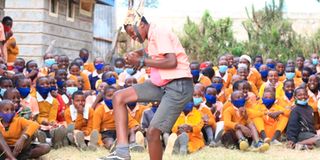Schools in need of 60,000 teachers as Form One double intake looms

A pupil performs a dance at Likii Primary School in Laikipia County on February 3. New learning areas in the CBC, such as performing arts, will require new teaching skills.
What you need to know:
- When the CBC is fully rolled out in secondary school, it will have six classes.
- Secondary school tutors not trained on how to handle CBC learners.
The government is staring at an acute staffing crisis in public secondary schools, with a double intake expected in two years that will necessitate hiring of a staggering 60,000 more teachers.
The crisis stems from the fact that two groups of learners who are now in different classes in primary school will join secondary school at the same time.
Secondary schools are expected to admit the pioneer Competency-Based Curriculum class, now in Grade Four, in January 2023.
This group of learners is expected to join Junior Secondary School (JSS) at Grade Seven under the new system.
This will also be the time learners who are currently in Standard Six will be joining Form One, but under the 8-4-4 curriculum, which is being progressively phased out.
The two curricula will run concurrently.
Another double intake is expected in 2024 and 2025, when the last lot under the old system, currently in Standard Five, joins secondary school.
With the government pushing for 100 per cent transition and with the enrolment numbers rising annually, more teachers who are conversant with the CBC approach will be needed.
Teacher shortage
When the 100 per cent transition policy was introduced in 2018, it created the need for an additional 27,000 teachers.
This emerges at a time the government, through the Teachers Service Commission (TSC), is under pressure to plug existing staff shortages, meaning much more money than has been previously budgeted will be required for hiring and training teachers on the CBC approach.
According to the TSC’s 2019-2023 Strategic Plan, teacher shortage in secondary schools when the pioneer CBC class joins JSS will be at 61,671.
The figure will be higher since it had been projected way before the decision to domicile JSS in the current secondary schools was made.
The teachers will also be trained on handling much younger learners as those joining JSS are expected to average 12 years, unlike in the 8-4-4 system where mean age of Form Ones is 14 years.
New learning areas such as sports science, performing arts and visual arts will also require new skills.
“The implementation of the Pathways and Tracks, while considering equity and cost-effectiveness, raises the issue of adequate preparations in terms of infrastructure and human resources (especially physical infrastructure for Technical, Engineering and Mathematics – STEM – and teachers for new learning areas),” a report by the CBC implementation task force released last week reads.
It calls for training on competency-based assessment of learners with different abilities.
Learner population
TSC has trained 150,000 primary school teachers on CBC at a cost of Sh1.8 billion since 2019, but is yet to begin training those in secondary school.
Apart from staffing, other school resources will be strained, a concern that has been raised by education players.
Learner population in secondary schools is expected to rise by 27 per cent in the first year, from 4,381,701 to 6,029,168.
When CBC is fully rolled out in secondary school, it will have six classes; three in junior and three in senior secondary.
This will call for extra classrooms, laboratories, workshops and music and sports equipment.
The thinking behind reducing the time learners spend in primary school to six years from eight and increasing that spent in secondary school was to give them more time to identify their areas of interest and to “specialise” in them when they choose one of the three pathways on offer.
These are Arts and Sports Science, Social Sciences or Science and STEM.
Each of the pathways will comprise various subjects.
Staffing crisis
Under the Arts and Sports Science Pathway, there will be Sports Science, Performing Arts and Visual Arts, whereas under the Social Sciences Pathway, learners will choose between two Tracks: Languages and Literature and Humanities and Business Studies.
STEM will offer learners Pure Sciences, Applied Sciences, Technical and Engineering as well as Careers and Technology Studies.
The staffing crisis is likely to be deepened further by the number of teachers expected to retire by 2023.
By the end of last year, some 16,645 teachers were 58 years old and above, meaning they will have retired by then. Primary schools had the most at 14,333 tutors.
Thousands of other teachers quit service through death, resignations and disciplinary action.
Teachers in secondary schools above 58 years of age are 2,651.
There are 209 curriculum support officers and 352 tutors in teacher training colleges, while those who retired in December are 479.
If the government provides the funds for hiring, it will be spoilt for choice as there are more than 350,000 teachers on the TSC register but not on its payroll. These are more what public and private schools require.
“If this rising number is not tamed through employment, public confidence in the nobility of the teaching profession will be eroded,” TSC chief executive Nancy Macharia said.





